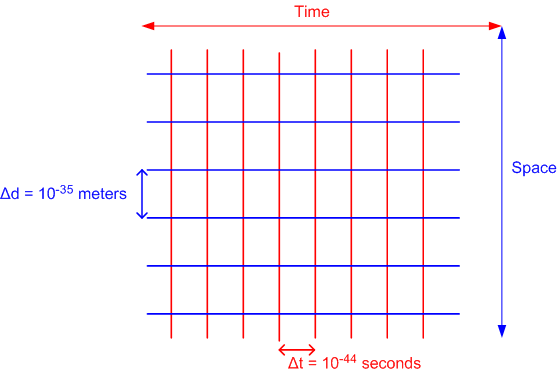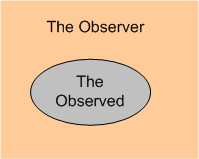Discrete, Not Continuous?
I’m in the process of reading my seventh layman’s book on quantum physics. It’s written by quantum physicist William Bray and its long winded title is: “Quantum Physics, Near Death Experiences, Eternal Consciousness, Religion, and the Human Soul“.
Mr. Bray writes something fascinating about space and time that I don’t recall seeing in any of the other QP books:
On a Planck scale, each moment exists in an isolated region (we call a Planck interval) of space-time existing only in the past or future to another point, and never in the present. No two things anywhere in space-time share a common present, no matter how close they are to one another, all the way down to 10**(-35) meters, or 10**(-44) seconds, apart. – William Bray (p. 31). Kindle Edition
In other words, Mr. Bray asserts that space and time are not continuous dimensions, they’re discrete. The universe is not analog, it’s digital. The movement of energy and matter in time is herky-jerky, jump-to-jump, like a motion picture. However, it “looks” smooth and continuous because of the lack of resolution and sensitivity of our woefully inadequate senses and sense-extending tools. D’oh!
Here’s what Wikipedia says about Planck time:
Theoretically, this is the smallest time measurement that will ever be possible. As of May 2010, the smallest time interval that was directly measured was on the order of 12 attoseconds (12 × 10**(−18) seconds)…. All scientific experiments and human experiences happen over billions of billions of billions of Planck times, making any events happening at the Planck scale hard to detect.
My interpretation is that we will never be able to mechanistically detect what happens between two adjacent planck time points.
So, what do you think exists between two adjacent, discrete, planck time points? Could it be that bits of infinite consciousness leak into the finite universe?
After doing some superficial research on Mr. Bray, I’ve become quite skeptical:
- There are no recommendations/testimonials from peers on the inside or backside covers of the book.
- Googling on “William Joseph Bray” doesn’t reveal that much.
- He’s got a facebook page, but I’m not a member so I didn’t get to see it.
- I discovered his web site, and his credentials seem to be too extensive to be believable.
Nevertheless, the book is a fascinatingly refreshing and novel read. In a nutshell, his main theme is that consciousness is not caused by bio-chemical processes in the brain, it’s quite the opposite. Infinite consciousness lies outside of the finite physical universe and it thus paints the universe into being by “collapsing the wavefunction“. Consciousness is the ultimate observer and it creates you and me and everything else in the universe.
Don’t forget, BD00 is a self-proclaimed L’artiste, so don’t believe a word he sez. What do you think?




A still pond is flat, almost invisible, reflecting the world as a perfect mirror. It is only when one throws a pebble and creates ripples does the surface become apparent.
All these attempts at measuring time and space are just different pebbles being tossed into the pond. When you start trying to slice something into discrete increments, there’s always another division possible.
Leave the danged pond alone and just enjoy the view.
You’re just biased cuz you live in water and you don’t want to get caught by a fisherman.
I like that, my credentials are too extensive to be believable.
My peer reviewed work doesn’t turn up in a google search because it is not public domain. You need access via a search engine dedicated to peer reviewed works in scientific literature; and any proprietary or classified work will not be published.
Just check the math.
dr wjb
Thanks for stopping by.
I think Mr. Bray is confused. You’ll find that his name doesn’t turn up in searches on sites like Google Scholar, SpringLink, Taylor & Francis etc. because his alleged work doesn’t exist. You’ll find little published work is in the public domain, yet virtually everything published in the last 40 years in reputable journals can be found via an online search — though you’ll likely need to pay to access it.
I would challenge Mr. Bray to provide a few article titles and the names of the journals said articles were published. I suspect this is a challenge that he can not meet.
I don’t see how BD00 came to the conclusion that Mr. Brays “credentials are too extensive to be believable” as I’ve yet to see any of his credentials! His academic degrees and the institutions that issued them, nor are the names of the companies that he claims to have been employed by, are listed anywhere.
In short, there is absolutely no way to verify the academic or work history of Mr. Bray. All we have are bold assertions as to his “extensive” career!
BD00 said: “seem to be too extensive to be believable” – not “are too extensive to be believable”. BD00 is as suspicious as you are, but the book is a really good read.
Some information in the public domain would include works by Kip Throne, Leonard Susskind, John Gribbin has an excellent web site; you can also look up terms such as ‘space-time foam’ in order to understand the quantization of space-time.
those are my off the cuff recommendations for further reading. Amit Goswami is also another good resource, as is Manjit Kumar.
Thanks for the resources. Your book was good, but my fave QP book is “Quantum Enigma”. I read Goswami’s “The Self-Aware Universe” and have seen him appear in a documentary.
The analog-digital dichotomy is a human construct. See my article below:
“The wave-particle dichotomy has a curious parallel in the analog-digital dichotomy that confronted the pioneers of computer sciences. The distinction between analog and digital became a topical issue in the 1940s, when computer scientists moved from analog to digital (more properly binary) computers. Binary systems were easier to program and more stable. They operate on discrete, binary currents (on and off), while analog computers operate on the less stable continuous variation in voltage.”
https://www.asiatimes.com/2019/08/opinion/why-quantum-physics-needs-asian-philosophy-2/
The analog-digital is a human construct. See my article here:
The wave-particle dichotomy has a curious parallel in the analog-digital dichotomy that confronted the pioneers of computer sciences. The distinction between analog and digital became a topical issue in the 1940s, when computer scientists moved from analog to digital (more properly binary) computers. Binary systems were easier to program and more stable. They operate on discrete, binary currents (on and off), while analog computers operate on the less stable continuous variation in voltage.
https://www.asiatimes.com/2019/08/opinion/why-quantum-physics-needs-asian-philosophy-2/
Nice article Jan. I read both parts and it resonated with me. I believe the eastern mystics definitely knew about quantum physics before there were any physicists and advanced math. 🙂